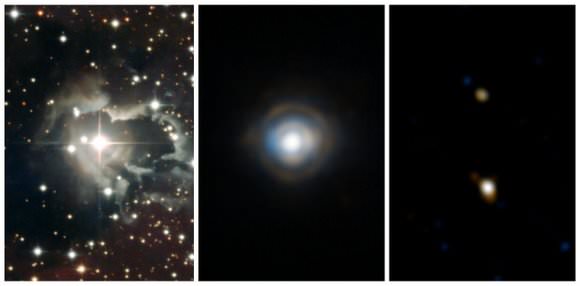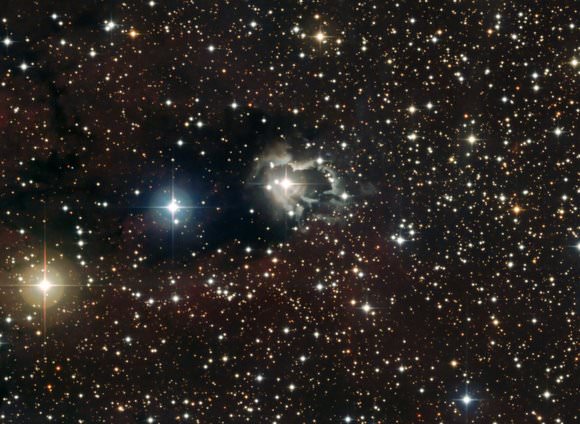A remarkable new view of the Milky Way toward the constellation Carina is alive with a flurry of stars — and the pièce de résistance is a binary star that’s all dressed up in a nebula of its own making.
The European Southern Observatory (ESO) released the new images this week.
The unusual star, HD 87643, has been extensively studied with several ESO telescopes, including the Very Large Telescope Interferometer (VLTI). Surrounded by a complex, extended nebula that is the result of previous violent ejections, the star has been shown to have a companion. Interactions in this double system, surrounded by a dusty disc, may be the engine fueling the star’s remarkable nebula.

HD 87643 is at the center of the extended nebula of dust and gas on the first image, obtained with the Wide Field Imager on the ESO/MPG 2.2-meter (7.2-foot) telescope at La Silla Observatory in Chile. The central panel is a zoom on the star obtained with NACO on ESO’s VLT on Paranal. The last panel zooms further , showing an image obtained with the AMBER instrument making use of three telescopes of the VLTI. The field of view of this last panel is less than one pixel of the first image.
HD 87643 is a member of the exotic class of B[e] stars — luminous, powerful blue stars with strong spectral evidence of hydrogen. The new image is part of a set of observations that provide astronomers with the best ever picture of a B[e] star.
The central star’s wind appears to have shaped the surrounding nebula, leaving bright, ragged tendrils of gas and dust. A careful investigation of these features seems to indicate that there are regular ejections of matter from the star every 15 to 50 years.
A team of astronomers, led by Florentin Millour of the Max-Planck Institute for Radio Astronomy in Bonn, Germany, has studied the star HD 87643 in great detail.
The sheer range of the observations, from the panoramic WFI image to the fine detail of the VLTI observations, corresponds to a zoom-in factor of 60,000 between the two extremes. The astronomers found that HD 87643 has a companion located at about 50 times the Earth–Sun distance and is embedded in a compact dust shell. The two stars probably orbit each other in a period between 20 and 50 years. A dusty disc may also be surrounding the two stars.
The presence of the companion could be an explanation for the regular ejection of matter from the star and the formation of the nebula: as the companion moves on a highly elliptical orbit, it would regularly come very close to HD 87643, triggering an ejection.
Source: European Southern Observatory (ESO). Check the site for more images and a video. A paper about the results is here.


Look at this part people:
“as the companion moves on a highly elliptical orbit, it would regularly come very close to HD 87643, triggering an ejection.”
Can you guys imagine it? I mean… geez… that´s a portrait! The star passing by the other and rising tons of stellar material up in to the space… some goes aways and some fall down at the main star creating starquakes or more….
Damn… and people still asks why I like astronomy!!
i hear ya Savino. was thinking the same thing. it’s amazing that we can watch from this ‘safe’ distance.
i’m more and more fascinated by the slow power of gravity. i mean i’m defying gravity right now with my arms in the air typing this. and that very same force eventually results in these massive stars billions of light years away. astounding.
To me this system resembles the reflection-emission nebula IC 59 and IC 63 near the bright B[e] star Gamma Cassiopeiae (w-companion, Btw ). The superficial appearance is most striking between the two, although the Gamma Cas nebula appears somewhat older 🙂 . Anyone else see the similarity?
Check out this awesome color view of IC 59-63 and Gamma Cas in glorious color and compare to the relatively younger nebula surrounding HD 87643. This image courtesey of jkcomeau posted at astrophotogallery.org 🙂
Ooops, the link to the Gamma Cas picture can be found here: http://astrophotogallery.org/showphoto.php/photo/1349/ppuser/20 . Eat your heart out.